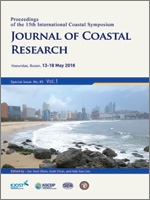Alonso, R.; Solari, S., and Teixeira, L., 2018. Erosion Problem on a Fluvial Beach. The Case Study of “La Concordia” in the Uruguay River. In: Shim, J.-S.; Chun, I., and Lim, H.S. (eds.), Proceedings from the International Coastal Symposium (ICS) 2018 (Busan, Republic of Korea). Journal of Coastal Research, Special Issue No. 85, pp. 131–135. Coconut Creek (Florida), ISSN 0749-0208.
A case study of beach erosion at “La Concordia” is presented. It is a fluvial beach located in the most downstream stretch of the Uruguay River. Despite it is a fluvial environment, the 10 km width that the river has in this zone allows for the generation of wind-waves that play an important role in the morphological processes that shape its sandy margins. This was initially proven by assessing the evolution of the coastline from satellite images and aerial photos, since the main change observed in the coastline is the expected one when groins are built on a sea coast. After that, the predominant influence of waves was confirmed by: 1) a good agreement between the geometry of the system (i.e. plan-shape and profiles) with the one predicted by formulations conceived from wave dominated marine environments, 2) a cross–section river flow velocity distribution, calculated for an historical maximum discharge, that shows that outside of the river channels velocities are lower than the critical expected for bottom sediment transport, 3) an estimation of the littoral transport in agreement with the historical coastline evolution. This verification supports the use of models and methods commonly employed in coastal engineering for the study of this type of fluvial beaches. In this case, the numerical model XBeach was used to simulate the response of the system to extreme events, in order to provide an input to a beach nourishment design.





